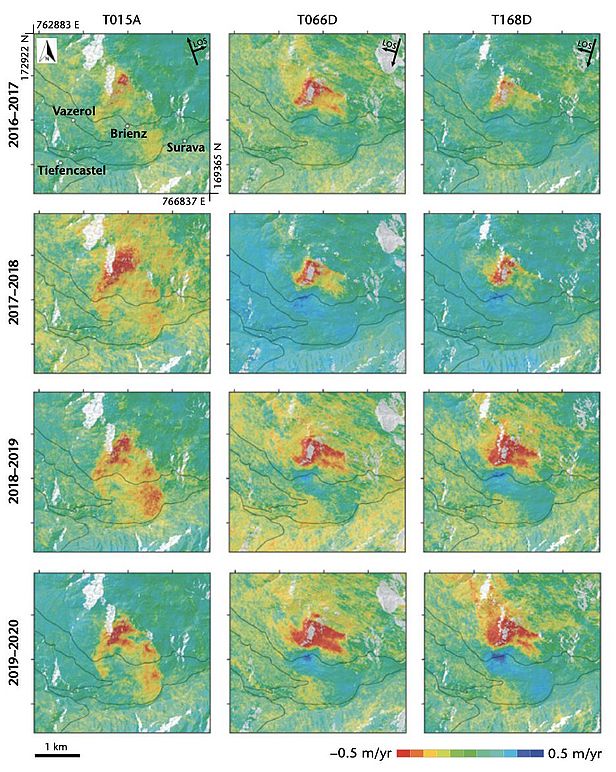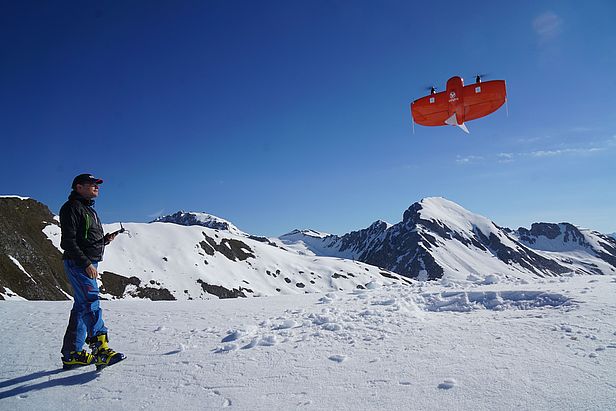08.08.2022 | Christine Huovinen | News SLF
The SLF's Alpine Remote Sensing research group tests and combines methods such as radar, photogrammetry and laser scanning to better monitor and predict natural hazards. It also makes this expertise available as a service to public authorities and engineering firms.
The SLF showcases the research groups of the Climate Change, Extremes and Natural Hazards in Alpine Regions Research Centre CERC, in no particular order. Founded in 2021, the CERC is sponsored by the Canton of Grisons and the Swiss Federal Institute for Forest, Snow and Landscape Research WSL and is supported by ETH Zurich. It is part of the SLF in Davos.
No other mountain village is currently in the headlines as often as Brienz/Brinzauls. The village is sliding downhill into the Albula Valley; although this shift has been occurring since time immemorial, it has recently accelerated. At present, the village moves around 1.5 metres per year, with movement of up to 10 metres recorded on the slope above the settlement. This endangers the homes of the 80 or so people who live in the village, as well as the up to 200 tourists who vacation there, and poses a hazard to the cantonal road between Davos and Lenzerheide and the Albula line of the Rhaetian Railway. The federal government and cantonal and communal authorities are working flat out to find solutions. They are supported by numerous experts from the field and research, including several SLF groups. Researchers from the SLF's Alpine Remote Sensing research group, which is part of the CERC, use radar satellites to measure where the slope is moving and how fast. They also regularly fly drones equipped with cameras over the village into areas that a radar satellite cannot cover with sufficient accuracy, thus providing additional image data.
Rapid observation of inaccessible areas
Remote sensing tools include radar, photogrammetry (calculations based on photos) and laser scanners. These collect information about the earth's surface or other objects without the need for measurements directly on site. Ground-, drone-, aircraft- and satellite-based remote sensing tools are becoming increasingly important for natural-hazard research, allowing comprehensive, high spatial resolution data to be collected quickly from a distance after disaster events, even in areas that are difficult to physically access.
Demand from the field

With natural hazards such as rockfall or landslides likely to occur more frequently as a result of climate change, the Alpine Remote Sensing research group wants to use its work to help boost safety in mountain regions. Yves Bühler, who heads up the group, says: "We develop and test remote sensing technologies to better monitor and predict natural hazards. As in Brienz/Brinzauls, we mainly use a combination of different technologies." However, Bühler and his team are not just focused on research: "It's important to us that we make our expertise available to cantons, communes and engineering firms as well." And there is plenty of demand for this service: for example, the safety officers in Bergün and La Punt use SLF drone data to decide when to open the Albula Pass in the spring. The avalanche protection measures proposed for the Bernina railway line are also based on snow depth maps calculated using drone images. Last but not least, the SLF's expertise is likely to remain in demand in Brienz/Brinzauls.
Contact
Links
- Alpine Remote Sensing research group
- CERC research centre
- Article in the WSL Magazine DIAGONAL about the application of remote sensing methods at Brienz: When the mountainside thunders down to the valley
Copyright
WSL and SLF provide the artwork for imaging of press articles relating to this media release for free. Transferring and saving the images in image databases and saving of images by third parties is not allowed.
